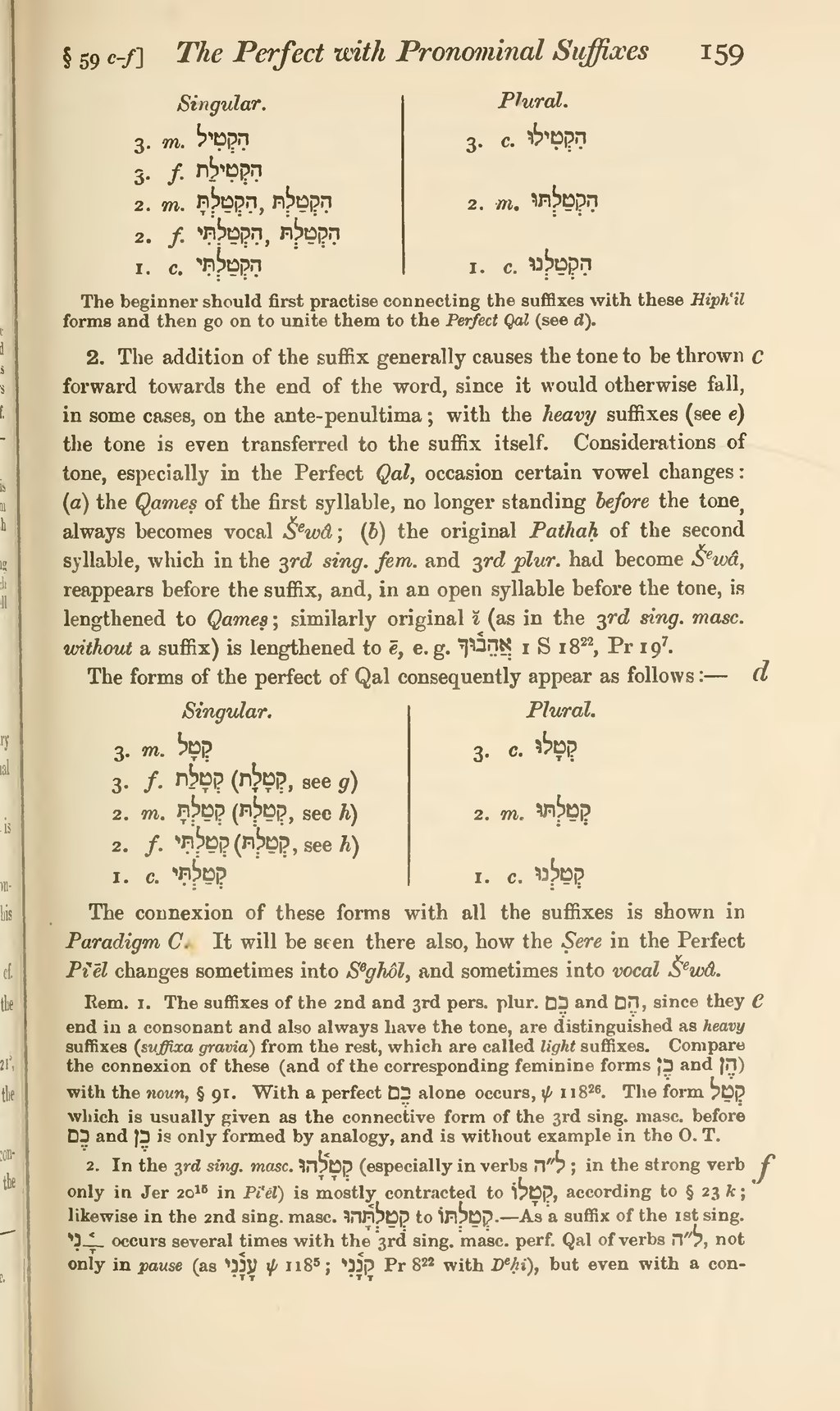| Singular. | Plural. |
| 3. m. הִקְטִיל | 3. c. הִקְטִילוּ |
| 3. f. הִקְטִילַת | |
| 2. m. הִקְטַלְתָּ, הִקְטַלְתּ | 2. m. הִקְטַלְתּוּ |
| 2. f. הִקְטַלְתִּי, הִקְטַלְתּ | |
| 1. c. הִקְטַלְתִּי | 1. c. הִקְטַלְנוּ |
The beginner should first practise connecting the suffixes with these Hiphʿîl forms and then go on to unite them to the Perfect Qal (see d).
[c] 2. The addition of the suffix generally causes the tone to be thrown forward towards the end of the word, since it would otherwise fall, in some cases, on the ante-penultima; with the heavy suffixes (see e) the tone is even transferred to the suffix itself. Considerations of tone, especially in the Perfect Qal, occasion certain vowel changes: (a) the Qameṣ of the first syllable, no longer standing before the tone, always becomes vocal Šewâ; (b) the original Pathaḥ of the second syllable, which in the 3rd sing. fem. and 3rd plur. had become Šewâ, reappears before the suffix, and, in an open syllable before the tone, is lengthened to Qameṣ; similarly original ĭ (as in the 3rd sing. masc. without a suffix) is lengthened to ē, e.g. אֲהֵב֫וּךָ 1 S 18, Pr 19.
[d] The forms of the perfect of Qal consequently appear as follows:—
| Singular. | Plural. |
| 3. m. קְטָל | 3. c. קְטָלוּ |
| 3. f. קְטָלַת (קְטָלָת, see g) | |
| 2. m. קְטַלְתָּ (קְטַלְתּ, see h) | 2. m. קְטַלְתּוּ |
| 2. f. קְטַלְתִּי (קְטַלְתּ, see h) | |
| 1. c. קְטַלְתִּי | 1. c. קְטַלְנוּ |
The connexion of these forms with all the suffixes is shown in Paradigm C. It will be seen there also, how the Ṣere in the Perfect Piʿēl changes sometimes into Seghôl, and sometimes into vocal Šewâ.
[e] Rem. 1. The suffixes of the 2nd and 3rd pers. plur. כֶם and הֶם, since they end in a consonant and also always have the tone, are distinguished as heavy suffixes (suffixa gravia) from the rest, which are called light suffixes. Compare the connexion of these (and of the corresponding feminine forms כֶן and הֶן) with the noun, § 91. With a perfect כֶם alone occurs, ψ 118. The form קְטַל which is usually given as the connective form of the 3rd sing. masc. before כֶם and כֶן is only formed by analogy, and is without example in the O.T.
[f] 2. In the 3rd sing. masc. קְטָלָ֫הוּ (especially in verbs ל״ה; in the strong verb only in Jer 20 in Piʿēl) is mostly contracted to קְטָלוֹ, according to § 23 k; likewise in the 2nd sing. masc. קְטַלְתָּ֫הוּ to קְטַלְתּוֹ.—As a suffix of the 1st sing. ־ָ֫ נִי occurs several times with the 3rd sing. masc. perf. Qal of verbs ל״ה, not only in pause (as עָנָ֫נִי ψ 118; קָנָ֫נִי Pr 8 with Deḥi), but even with a con-

